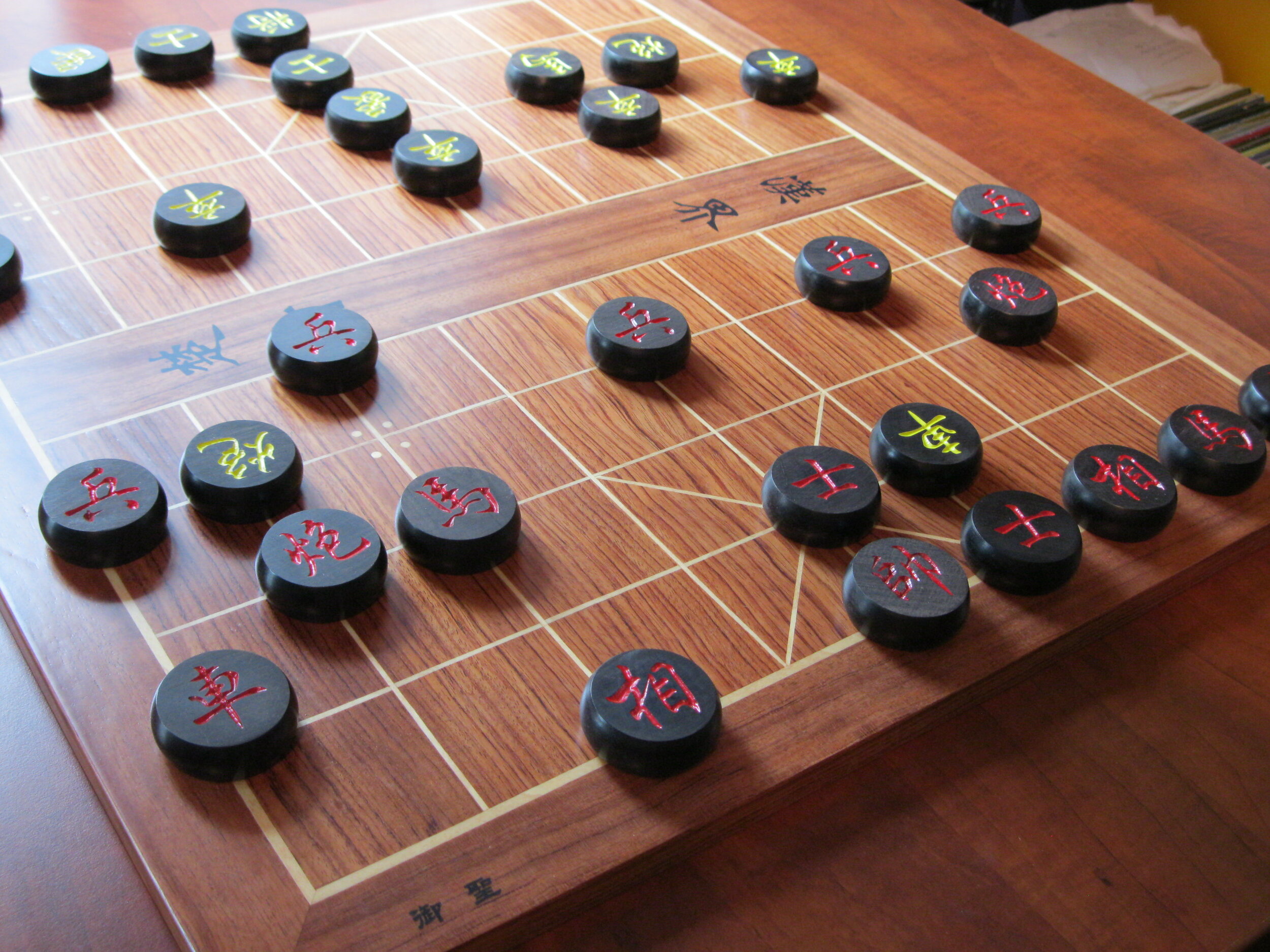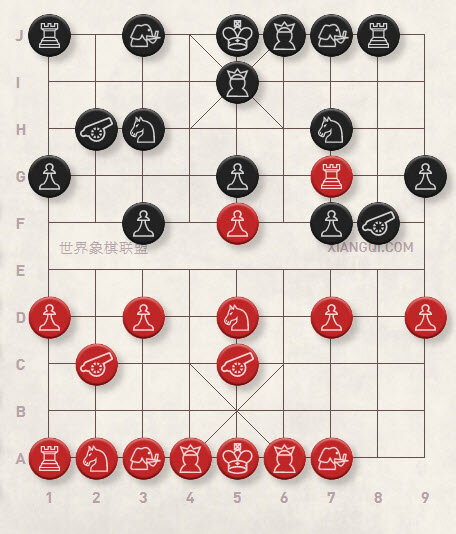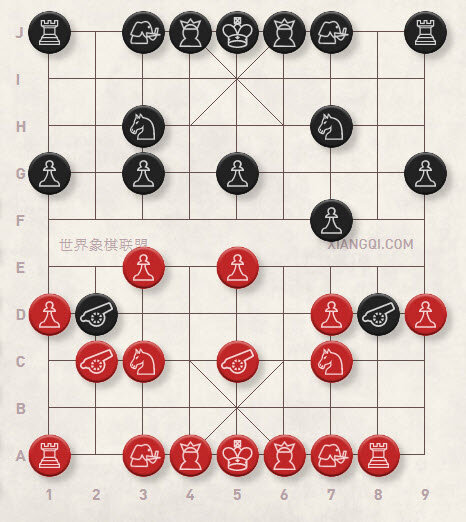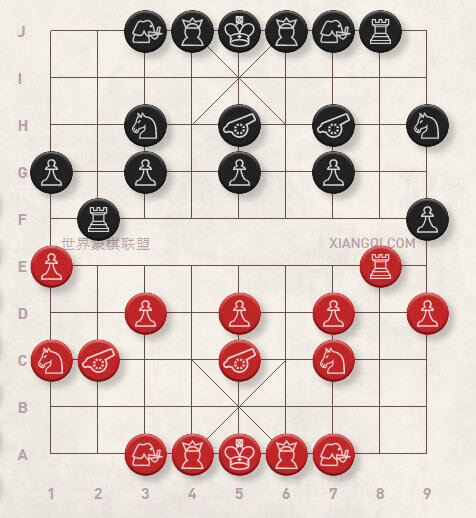Choosing your Xiangqi (Chinese Chess) Opening
Author: Jim Png from XqInEnglish
The opening phase is perhaps the phase of the game where most people are interested. To be proficient in Xiangqi, a basic knowledge of the opening system is a must. Yet, there are hundreds of variations to learn from in Xiangqi, and it would be impossible for a beginner to know ALL the opening lines. Each of these opening lines would have its own 'temperament' and character. Some have a breakneck pace, while others are less volatile, emphasizing accumulating small advantages to enter the endgame with a winning position. As with humans, different Xiangqi opening lines have different temperaments and innate characteristics, much like people with other dispositions and tempers.
Therefore, choosing an opening line or opening system that fits the player's style is recommended. It would be much more fun and easier to master. After being proficient in an opening system, the player could dive into other opening systems and learn more.
As the playstyle would often reflect the player's natural tendencies and character, it would be recommended to choose specific opening Xiangqi lines that would best fit the players' personality. Unfortunately, beginners to Xiangqi are often clueless and do not know what to choose.
This article would be a short introduction to Xiangqi openings' characteristics and include some pointers on how to choose the right opening line. For a summary of orthodox Xiangqi opening systems, please refer to an earlier article that the webmaster wrote in 2020.
This article is to be presented in the following manner:
Contents
A Short Summary of the Different Opening Moves and Counters in Xiangqi
The Traditional Way of Classifying Xiangqi Openings
Classifying Xiangqi Openings based on the style of play
Rapid Attacks (Blitzkrieg) Style 急攻型 jí gōng xíng
Measured Attack Style 缓攻型 huǎn gōng xíng
Tooth for Tooth Style 对攻型 duì gōng xíng
Slow and Steady Style 稳健性 wěn jiànxìng
Modern Style 新潮型 xīn cháo xíng
Unorthodox Style 冷门型 lěng mén xíng
Fashionable Opening Lines/Variations 流行型 liú xíng xíng
Scattered/ Formless Style 散手型sǎn shǒu xíng
Some important concepts
Red would start the game and could choose to be aggressive and attack with the first move. He could also choose to consolidate his defense and play defense right at the beginning and, when the time is ripe, start his attack.
Black will have to counter Red's plans. For example, if Red chose to attack aggressively, Black could decide to defend first before attacking. Or Black could be aggressive and start fighting tooth for tooth right from the beginning.
The former situation would usually indicate a slower pace of the game and allow both Red and Black to formulate better plans to counter the enemy. The margin for error would be more significant, and the effects of making a mistake would not be as severe. Red would usually continue to hold on to a slight initiative going into the midgame. People who are more patient would usually choose such lines.
If Red started with a defensive tone, Black could consider starting to attack immediately where Black would fight for the initiative. Black could choose to play defense and consolidate his position before attacking, which would slow the entire game's pace.
If both colors decided to go at it right from the beginning, the game's pace would be faster, and it would be harder for either player to control the game. The margin for error would be significantly smaller, and often, any mistake made would result in drastic consequences. Such a strategy is usually chosen by Black when he must score a win.
A Short Summary of the Different Opening Moves and Counters in Xiangqi
Before continuing, it would be imperative to have some background knowledge of the opening in Xiangqi.
In a nutshell, there are four basic orthodox opening systems in Xiangqi (Chinese Chess). The most commonly played first moves are:
· Central Cannon (中炮 zhōng pào, C2=5/C8=5)
· Pawn Opening (仙人指路 xiān rén zhǐ lù, P3+1/P7+1)
· Elephant Opening (飞相局 fēi xiàng jú, E3+5/E7+5)
· Horse Opening (起马局 qǐ mǎ jú, H2+3/H8+7)
Other less commonly seen opening moves, which are also considered to be orthodox, would be the Palcorner Cannon Opening (士角炮 shì jiǎo pào, C2=4/C8=6) and the Cross-Palace Cannon Opening (过宫炮guò gōng pào, C2=6/C8=4)/
Amongst the four major opening systems, the most-commonly played move would be the Central Cannon which accounts for over half of ALL the games played in tournaments. It would be no surprise that the counters against Red's Central Cannon would be the most-commonly studied Black counters.
Common Black counters against the Central Cannon would include:
· Same Direction Cannons (顺炮 shùn pào, 1. C2=5 C8=5)
· Opposite Direction Cannons (列炮 liè pào, 1. C2=5 C2=5)
· Screen Horse Defense (屏风马 píngfēng mǎ, 1. C2=5 H8+7 2. C2=5 H2+3)
· Sandwiched Horse Defense (反宫马 fǎn gōng mǎ, 1. C2=5 H2+3, 2. H2+3 C8=6, 3. R1=2 H8+7)
· Single Horse Defense (单提马 dān tí mǎ, 1. C2=5 H2+3, 2. H2+3 H8+9)
Photography courtesy of Rick Knowlton
The Traditional Way of Classifying Xiangqi Openings
There are many different classifications of the Xiangqi openings. In the past, it was usually based on the technical aspects of a particular opening system. To name a few opening systems:
· Central Cannon vs. Screen Horse Defense (中炮对屏风马 zhōng pào duì píng fēng mǎ)
· Central Cannon vs. Sandwiched Horse Defense (中炮对反宫马 zhōng pào duì)
· Same Direction Cannons (顺炮 shùn pào)
· Opposite Direction Cannons (列炮, liè pào)
· Pawn Opening vs. Thundering Defense (仙人指路对卒底炮 xiān rén zhǐ lù duì zú dǐ pào/)
· Elephant Opening vs. Left Central Cannon (飞相局对左中炮 fēi xiàng jú duì zuǒ zhōng pào )
Classifying Xiangqi Openings based on the style of play
As can be seen, the early classification of the Xiangqi opening was based mainly on the formations chosen by both colors. It did not mention or emphasize the characters of the Xiangqi opening.
Towards the end of the twentieth century, there were attempts by different Xiangqi authors to classify the style that other Xiangqi opening lines demonstrated.
The reader might argue that the game's pace could alter significantly if there were changes in the strategy or style of play. Indeed, this would be the case. The main idea behind this section would be to discuss the pros and cons of the different play styles so that the player would have a better idea of what to do on the board.
The following characters have been identified and cited: (1 p. 3) (2 页 53)
· Rapid Attacking (Blitzkrieg) Style 急攻型 jí gōng xíng
· Measured AttackingStyle 缓攻型 huǎn gōng xíng
· Tooth for Tooth Style 对攻型 duì gōng xíng
· Slow and steady Style 稳健性 wěn jiànxìng
· Modern Style 新潮型 xīn cháo xíng
· Unorthodox Style 冷门型 lěng mén xíng
· Fashionable Style 流行型 liú xíng xíng
· Scattered/ Formless Style 散手型 sǎn shǒu xíng
· Symmetrical Style 对称式阵型 duì chèn shì zhèn xíng
These different styles can be further differentiated by color. For example, Red could adopt a slow but steady attacking style while Black could decide to counter in an unorthodox manner. Or Red could attack right from the first move to attack, hoping to capture Black unawares.
Rapid Attacks (Blitzkrieg) Style 急攻型 jí gōng xíng
The strategy behind this style would be that Red would throw caution to the wind and attempt an attack right from the beginning. It would be a do-or-die situation. It would be analogous to the Blitzkrieg attack used in World War 1 attributed to General Carl von Clausewitz. According to www.history.com, Blitzkrieg is defined as (3)
Blitzkrieg is a term used to describe a method of offensive warfare designed to strike a swift, focused blow at an enemy using mobile, maneuverable forces, including armored tanks and air support. Such an attack ideally leads to a quick victory, limiting the loss of soldiers and artillery.
Rapid attacks have been present in Xiangqi for centuries, and these attacks would often lead to very difficult positions, and the margin for error is very slim. The game could be decided if one mistake were made. Sacrifices are very common, and the emphasis on formations would be less noticeable. Focus is solely on the attack, and tactical combinations play a considerable role.
The advantages of such an opening would be that Red would develop only three or four pieces in an all-out attack, hoping to catch the enemy unawares or before the opposing color can come up with a formidable defense.
The disadvantages, however, are also significant as Red would have forsaken the development of his other pieces.
Such a style of attack is not very commonly seen in actual competition. For example, in the 2019 A-League, there are only two or three times when Red would use such an opening. Rapid attacks are not popular because professional Xiangqi players prefer to play in situations where they have more control over the situation.
However, for amateur players, these opening variations are popular, especially in rapid chess, whereby the time to think and postulate the probabilities is limited.
The most prominent example of such an opening would be the Central Cannon with Rapid Central Pawn Advancement Variation (中炮急进中兵 zhōng pào jí jìn zhōng bīng). It has an interesting Chinese name called 牛头滚 (niú tóu gǔn). 牛头would be the head of a bull while 滚would be to roll forward. It has been translated as the Charging Bull Variation by the author. (4)
There are many books, magazines, and online articles that have studied this opening variation deeply.
1. C2=5 H8+7 2. H2+3 P7+1
3. R1=2 R9=8 4. R2+6 H2+3
The primary opening formation is now defined.
Red:Central Cannon with Pawn Ranked Chariot.
Black: Screen Horse Defense with 7th Pawn Advancement.
5. P5+1 …………
Instead of playing P7+1 as is most commonly seen, Red would choose to attack from the central file with P5+1.
This would be the infamous Charging Bull Variation.
At this point, Red's moves have focused solely on his attack on the central file. His left flank would NOT have been developed at all.
5. ………… A4+5
Black consolidates the central file in preparation for Red's blatant attack on the main file.
6. P5+1 P3+1
This would be the infamous Charging Bull Variation.
Red would have used the Central Cannon with Pawn Ranked Chariot with Rapid Central Pawn Advancement.
Black would have countered with the Screen Horse Defense with 7th Pawn Advancement Variation.
Red had charged forward his Central Pawn at the expense of underdevelopment of his left flank.
Black's P3+1 is considered orthodox as Black would be prepared to play C2+1 to dislodge the Red Chariot to relieve some of the pressure that Red had mounted.
7. R2=3 …………
Since Black was prepared to play C2+1, Red countered with R2=3. Black cannot play C2+1 now, or he would lose his left Horse. In this way, Red would have strengthened his position on the central file.
7. ………… C8+2
Black countered with the Riverbank Cannon to try to dislodge the Red central Pawn.
8. H3+5 …………
According to the article, it would be a mistake if Red rushed his attack with P5+1. He felt that H3+5 was sound, but computer analysis of the position would suggest otherwise. Black would have a slight advantage after Red played H3+5.
P5+1 was okay, and it would lead to an actual situation.
As can be seen, Red would be pounding very hard on the central file. A small mistake by Black could result in huge losses. Such situations are very complicated and hard to control.
Measured Attack Style 缓攻型 huǎn gōng xíng
This style of play would be much slower-paced than the Rapid Attacking Style mentioned above. The player would be more deliberate in his moves, considering his defense and attack at the same time.
Weaknesses would not be so easily identified. The advantages of such a style of play include better control of the situation. Any mistake made by the enemy could also lead to huge gains.
Once the initiative has been claimed, the player would accumulate small advantages, and hopefully, over time, these advantages would turn into a winning position.
Of course, the chances of the game turning into a draw would be much more significant.
The vast majority of the opening lines played by the Xiangqi Masters and Grandmasters often use this style. There are too many variations to be listed in this article, but many variations of the 56 Cannons, 57 Cannons, and 58 Cannons come to mind when describing this play style.
The following example is from Grandmaster Hu Ronghua's Sandwiched Horse Defense Treatise. It would be the 2nd board of Chapter 5. (5)
1. C2=5 H2+3 2. H2+3 C8=6
3. R1=2 H8+7 4. P3+1 P3+1
5. H8+9 E7+5 6. C8=7 …………
Compared to the 56 Cannons and the 58 Cannons, using the 57 Cannons would lead to a more volatile game.
6. ………… R1=2 7. R9=8 C2+4
Black must push his cannon across the river to limit the movement of the Black chariot. If Black played A6+5, Red would immediately continue with R8+4. Red would then be prepared to play P7+1 to exchange pawns and increase his initiative.
At this point in the game, Red would usually choose to play either P7+1 or R8+1.
The author has made a short video of this opening line from the book that can be assessed on Youtube at the following link.
As can be seen, neither color would have a significant advantage, but there is already some contact with the forces.
Tooth for Tooth Style 对攻型 duì gōng xíng
As the saying goes, "Attack is the best defense."
Tooth for Tooth counters refers to opening lines whereby both colors go at it right from the start. The primary strategy is to fight fire with fire. Emphasis is on tactical combinations with less regard for defense.
Many opening variations of the Same Direction Cannons or the Double Pawn Rank Cannons Variation are examples of such an opening system. (6)
1. C2=5 H8+7 2. H2+3 H2+3
3. R1=2 R9=8 4. P7+1 P7+1
5. H8+7 C2+4 6. P5+1 C8+4
As can be seen, Black would have formed a blockade and compressed the space that Red could move. Red would be compensated with an attack on the central file.
This opening system is one of the most aggressive counters of the Screen Horse Defense against the Central Cannon.
Slow and Steady Style 稳健性 wěn jiànxìng
Opening lines with this style demonstrate a slower pace of the game. The main emphasis would be to consolidate one's position and patiently await the time to attack. It would be a stark contrast to the Rapid Attacking style or Tooth for Tooth Style as mentioned above.
Opening lines or systems that come to mind include various opening lines of the Pawn Opening, Palcorner Cannon Opening, Elephant Opening, Horse Opening, et cetera.
Shown below is one of the opening lines for the Elephant Opening vs. Cross Palace Cannon Counter. (1)
1. E3+5 C8=4 2. H2+3 H8+7
3. R1=2 P7+1 4. P7+1 R9+1
5. C2=1 E3+5 6. R2+4 R9=3
7. H8+9 H2+1 8. P9+1 P3+1
As can be seen, after eight plies do, the first contact of the pieces occurs. There are no apparent attacks, and the riverbank is the first battleground. Both colors have also considerably consolidated their defenses and adopted distinct formations.
Modern Style 新潮型 xīn cháo xíng
The Xiangqi opening has undergone evolutionary changes since the Secret in the Tangerine in the Ming Dynasty. The old variations have been studied in so much detail that new ways of playing the same position have evolved with different emphasis during the maneuvering of the pieces.
These new ways of playing the same position are known as the modern style.
The appearance of these new opening lines does not mean that the ancient manuals' content should be dismissed. On the contrary, the ancient manuals' content should still be studied in detail to fully understand the modern opening lines' intricacies.
Unorthodox Style 冷门型 lěng mén xíng
Unorthodox opening lines refer to variations that are considered NOT to be viable in actual play. Yet, their peculiar opening positions or formations still have their own 'attractiveness.' And if the opponent is not familiar with the characteristics of such opening lines, it would be effortless to trap the opponent and gain a significant advantage using these peculiar opening variations.
Black's Parrot Cannons, Turtle Back Cannons, Tandem Cannons, et cetera are some of the most infamous opening lines in this category.
The author has written an article called "Unorthodox Opening Systems in Xiangqi (Chinese Chess)" in the past, which has introduced most of the unorthodox opening systems for both Red and Black.
Fashionable Opening Lines/Variations 流行型 liú xíng xíng
These opening lines are mainly obtained from the major tournaments. Any new opening line that a Grandmaster or Master plays with good results would immediately spark interest in the variation.
These opening lines are usually discussed on the forums with analyzed as featured articles in the subsequent few editions of the various periodicals.
Scattered/ Formless Style 散手型sǎn shǒu xíng
While most opening systems stress the importance of specific formations, scattered or formless opening lines refer to opening variations that do not conform to standard practices. They are not considered unorthodox lines as even unorthodox lines have specific formations that can be identified.
Perhaps the best way to describe the strategy behind these lines would be Bruce Lee's famous quote: "Be like water." Such opening lines are much more demanding on the analytical skill of the player. Players with solid midgame and endgame skills also tend to prefer such opening lines. Indeed, there are many times in tournaments whereby players might deliberately choose such opening lines to prevent falling into traps by players known for their strengths and cunning in the opening phase.
If it is formless, it cannot be prepared!
Examples of these types of opening lines include many variations of the Pawn Opening.
Symmetrical Style 对称式阵型 duì chèn shì zhèn xíng
These opening lines have a common trait: Black would copy Red move for move such that there was symmetry on the board. Unfortunately, such opening lines would usually favor Red as there would be a time where eventually Black cannot continue copying the moves.
Such opening lines include the Opposite Direction Cannons and the Pawn vs. Pawn Opening.
Shown below is an opening variation of the Opposite Direction Cannons from the ancient manual Secret in the Tangerine. The comments are from the book that the author as published a few years ago.
1. C2=5 C2=5
Opposite Direction Cannons. If Black played C8=5, it would be known as the Same Direction Cannons.
2. H2+3 H8+9
This would be one of the defining moves of the major variation, whereby H8+9 was played. If H8+7 were played, it would lead to the minor variation.
3. R1=2 R9=8 4. H8+9 …………
Developing the left Horse as an edge horse was commonly done in the ancient manual.
4. ………… H2+3 5. R9=8 R1=2
P1+1 was also discussed in the ancient manual whereby Black would try to slow the development of Red's edge horse.
6. P9+1 P9+1
And this would be the defining position for the Major variation of the Opposite Direction Cannons.
7. R2+4 R2+4
Thus far, Black had 'copied' Red's play move for move, leading to a perfect symmetry on the board. This was one of the major characteristics of the ODC. However, Red would still have the initiative by virtue of making the first move. That is why Black would be at a disadvantage as there would come a time when Black would not be able to copy Red's moves anymore.
Summary
When learning the Xiangqi opening, other than being engrossed with the technical aspects of the game, it would be a good idea to understand the 'temperament' of a particular opening line. Knowing the temperament would help decision-making greatly.
For example, suddenly switching to defense in a rapid attack line would often result in a loss of tempi and allow the enemy to make gains in various fields.
The author cannot stand playing the same variation or counter, so he varies the opening now and tries to increase the game's fun.
However, it would be a good idea for beginners to stick to a particular line and master it well while dabbling at other variations. It would also be recommended to choose various opening lines that would best fit your character. For example, aggressive players could choose the Central Pawn Advancement variation of the central cannon as Red, and the Double Pawn Ranked Cannons Variation of the Screen Horse Defense as Black.
Players who have a less aggressive nature can choose the other Central Cannon Variations or the Elephant Opening or Pawn Opening.
Whatever variation you choose, be sure to know it as detailed as possible so that you would not sustain any disadvantages going into the midgame phase.
Works Cited
1. 刘, 殿中. 象棋新编教程 象棋布局精要. 北京 : 北京体育大学出版社, 2000. 7-81051-486-5/G.416.
2. 屠, 景明 and 杨, 柏伟. 象棋词典. 上海 : 上海文华出版社, 2009. 978-7-80740-339-5/G。475.
3. editors, History.com. Blitzkrieg. www.history.com. [Online] Nov 4, 2019. [Cited: Mar 21, 2021.] https://www.history.com/topics/world-war-ii/blitzkrieg.
4. 象棋文化交流. 最具攻勢的象棋開局是什麼?30年棋齡的老棋痴告訴你答案. 每日头条. [联机] 2019年Aug月30日. [引用日期: 2020年Mar月21日.] https://kknews.cc/zh-tw/sports/klknjxp.html.
5. 胡, 荣华. 夹炮屏风 反宫马布局研究. Hong Kong and Singapore : 香港业余象棋协会 新加坡北斗象棋研究会, 1983.
6. 刘, 殿中. 象棋新编教程 象棋初学门径. 北京 : 北京体育大学出版社, 2000. 7-81051-484-9.







